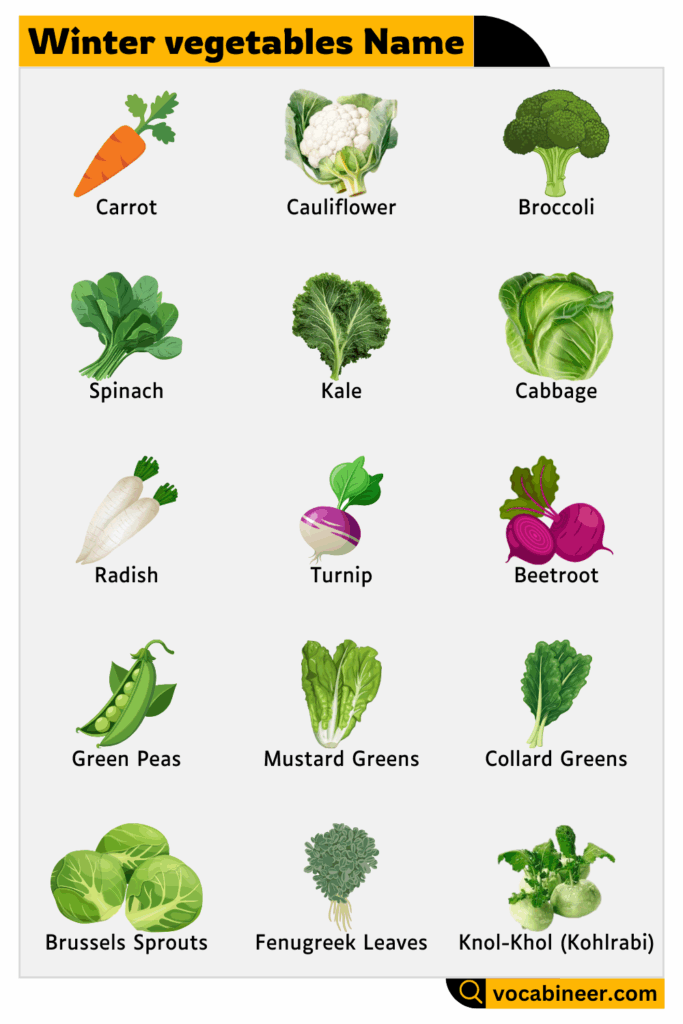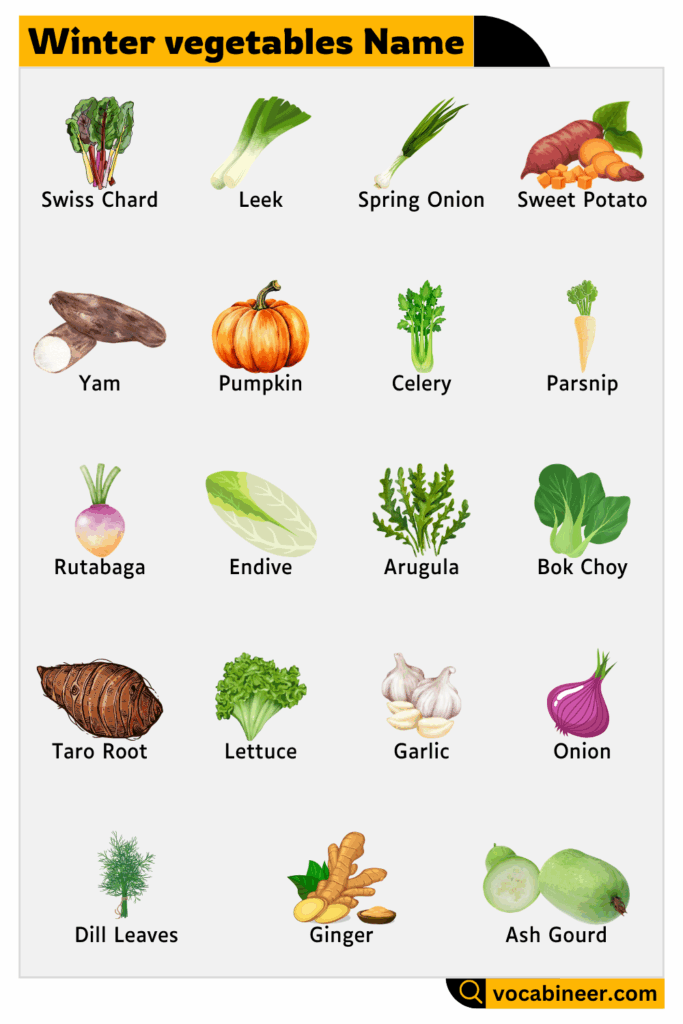Winter vegetables are cold-weather plants that grow during late autumn and winter. Learning winter vegetables name with picture builds English vocabulary and helps identify common cool-season crops like root vegetables and leafy greens. This resource supports learners who want to recognize, understand, and remember vegetables that grow in winter for seasonal learning, gardening, and diet awareness.
In This Page
Winter Vegetables Name in English with Picture

- Cabbage: A leafy vegetable that grows well in cold weather and is often used in salads or cooked dishes.
- Cauliflower: A white vegetable that looks like a flower and is good for soups and roasting.
- Broccoli: A green vegetable with little tree-like heads, full of vitamins and great steamed or cooked.
- Kale: A dark green leafy vegetable that is healthy and used in salads or cooked meals.
- Spinach: A soft green leaf that grows in cold weather and is full of nutrients.
- Mustard Greens: Leafy greens with a little spicy taste, good for cooking or salads.
- Collard Greens: Large green leaves that are cooked slowly, very healthy in winter dishes.
- Turnip: A round root vegetable with a mild, slightly sweet taste, used in soups and stews.
- Radish: A small, crunchy root vegetable with a peppery flavor, often eaten raw.
- Carrot: A sweet, orange root vegetable that grows in cold weather and can be eaten raw or cooked.
- Beetroot: A red root vegetable with an earthy flavor, used in salads and cooking.
- Leek: A long vegetable similar to onion, used for flavor in soups and stews.
- Brussels Sprouts: Small green balls that look like tiny cabbages and taste great roasted or steamed.
- Green Peas: Small, round green vegetables that grow in pods and are sweet to eat.
- Snow Peas: Flat green pods with small peas inside, often cooked in stir-fries.
- Lettuce: A leafy green used mainly in salads, some kinds can grow in winter.
- Swiss Chard: Leafy green vegetable with colorful stems, used in cooking or salads.
- Bok Choy: A kind of Chinese cabbage with white stems and green leaves, used in stir-fries.
- Arugula: A green leafy vegetable with a peppery taste, added to salads.
- Endive: A leafy vegetable with a slightly bitter taste, used in salads or cooked dishes.
- Fennel: A crunchy vegetable with a mild sweet flavor like licorice, used in cooking.
- Kohlrabi: A round vegetable with a sweet taste, eaten raw or cooked.
- Parsnip: A white root vegetable similar to carrot, sweet when cooked.
- Rutabaga: A large root vegetable with a sweet and slightly spicy taste, cooked or roasted.
- Celery: A crunchy green vegetable used in salads, soups, and as a snack.
- Garlic: A small bulb used to add strong flavor in many dishes.
- Onion: A common vegetable used to add flavor to many recipes.
- Shallots: Small, mild onions used for flavor in sauces and dishes.
- Spring Onion: Young onions with green stalks, used fresh or cooked.
- Celeriac: A round root with celery flavor, used in soups and stews.
- Daikon: A large white root vegetable used in cooking and salads.
- Mizuna: A leafy green with a mild peppery taste, used in salads and cooking.
- Tatsoi: Small, dark green leaves with a mild taste, used in soups and salads.
- Chicory: A leafy vegetable with a bitter taste, eaten raw or cooked.
- Sorrel: A green leaf with a sour taste, used in salads and soups.
- Watercress: A green plant with a peppery flavor, often eaten fresh in salads.
- Mâche: A small, mild-flavored leafy green used in salads.
- Radicchio: A red leafy vegetable with a bitter taste, used in salads or grilled.
- Jerusalem Artichoke: A root vegetable with a sweet, nutty taste, used in soups and roasting.
- Horseradish: A spicy root used to add heat to dishes.
- Parsley: A green herb used fresh or dried to add flavor.
- Sage: A fragrant herb used in cooking, especially in winter meals.
- Thyme: A small herb that adds flavor to many dishes.
- Rosemary: A strong-smelling herb used in roasting and stews.
- Purple Sprouting Broccoli: A type of broccoli with purple stems and a tender taste.
- Baby Carrots: Small, sweet carrots harvested early, eaten raw or cooked.
- Garlic Scapes: The green shoots of garlic plants, mild and tasty for cooking.
- Sea Kale: A leafy green vegetable that grows near the sea, eaten like cabbage.
- Chinese Cabbage: A mild-tasting cabbage used in Asian cooking.
- Green Onions: Also called scallions, young onions used fresh or cooked.
Complete List of Winter Vegetables Name in English
- Cabbage
- Cauliflower
- Broccoli
- Kale
- Spinach
- Mustard greens
- Collard greens
- Turnip
- Radish
- Carrot
- Beetroot
- Leek
- Brussels sprouts
- Green peas
- Snow peas
- Lettuce
- Swiss chard
- Bok choy
- Arugula
- Endive
- Fennel
- Kohlrabi
- Parsnip
- Rutabaga
- Celery
- Garlic
- Onion
- Shallots
- Spring onion
- Celeriac
- Daikon
- Mizuna
- Tatsoi
- Chicory
- Sorrel
- Watercress
- Mâche
- Radicchio
- Jerusalem artichoke
- Horseradish
- Parsley
- Sage
- Thyme
- Rosemary
- Purple sprouting broccoli
- Baby carrots
- Garlic scapes
- Sea kale
- Chinese cabbage
- Green onions
Winter Leafy Greens Vegetables Name with Picture
Winter leafy greens are cold-tolerant vegetables with green, leafy parts that provide important nutrients and grow well during the colder months.
- Spinach
A dark green leafy vegetable packed with iron, vitamins A and C. Spinach grows well in cool weather and is rich in antioxidants that support overall health. - Kale
A hardy green with curly leaves, kale is full of vitamins K, A, and C. It thrives in cold climates and becomes sweeter after frost. - Collard Greens
Large, flat leaves rich in fiber and calcium. Collard greens grow well in winter and are known for their strong, slightly bitter flavor. - Mustard Greens
Spicy, peppery leaves that add flavor to winter meals. These greens are rich in vitamin K and antioxidants. - Swiss Chard
Brightly colored stems with dark green leaves. Swiss chard is nutrient-dense and grows well in cool temperatures. - Winter Lettuce
Special lettuce varieties bred to tolerate cold. They remain tender and fresh in winter gardens. - Arugula
Peppery leafy green that grows quickly in cold weather and adds a spicy kick to salads. - Mizuna
A Japanese mustard green with feathery leaves, tolerant to cold and rich in vitamins. - Tatsoi
Small, spoon-shaped leaves that thrive in cold climates and offer a mild, spinach-like flavor. - Endive
A leafy green with slightly bitter taste, endive grows well in cooler months and adds crunch to salads.
Root Vegetables That Grow in Winter with Pictures
Root vegetables grow underground and are hardy plants that survive cold weather, making them perfect for winter harvesting and meals.
- Carrot
A crunchy, orange root rich in vitamin A and fiber. Carrots grow well in cold soil and develop a sweeter taste after frost exposure, making them a nutritious winter staple. - Parsnip
Pale and sweet, parsnips have a nutty flavor and thrive in cold weather. They are high in fiber and vitamins, improving in sweetness during winter months. - Turnip
Turnips have white or purple skin and grow well in cool climates. Rich in vitamin C and fiber, they support digestion and immunity during cold seasons. - Radish
Small and spicy, radishes mature quickly in chilly weather. They add a crisp texture to salads and are rich in antioxidants and vitamin C. - Beetroot (Beets)
Deep red and nutrient-dense, beets contain antioxidants, fiber, and minerals like iron. They grow well in cold soil and are versatile for cooking and juicing. - Rutabaga
Also called swede, rutabagas are large root vegetables with a mild, sweet flavor. They are cold-hardy and rich in vitamin C and fiber. - Salsify
Known as “oyster plant,” salsify has a creamy white root with a subtle oyster-like taste. It grows well in cold climates and is a good source of fiber and minerals. - Jerusalem Artichoke (Sunchoke)
A knobby root that stores well in winter, it is high in inulin, a type of fiber that supports gut health and blood sugar control. - Celeriac (Celery Root)
This knobby root vegetable tastes like celery and parsley and grows well in cold soil. It is rich in vitamins and fiber. - Sweet Potato
Although less cold-tolerant, some varieties can be harvested late in fall for winter use. Sweet potatoes provide complex carbohydrates and vitamins.

Healthy Winter Vegetables Name and Their Health Benefits
Cabbage
Rich in vitamins C and K, cabbage helps boost your immune system and supports healthy bones.
Spinach
Full of iron and antioxidants, spinach improves blood health and fights inflammation.
Carrot
High in beta-carotene, carrots are great for eye health and support a strong immune system.
Broccoli
Contains fiber and vitamin C, which help digestion and strengthen your body’s defenses.
Brussels Sprouts
Loaded with vitamins and fiber, they aid digestion and may reduce the risk of some diseases.
Garlic
Known for its antibacterial properties, garlic supports heart health and boosts immunity.
Kale
Packed with vitamins A, C, and K, kale supports skin health, vision, and blood clotting.
Leek
Good source of vitamins A and C, leeks help improve heart health and digestion.
Beetroot
Contains nitrates that improve blood flow and lower blood pressure.
Parsnip
High in fiber and vitamins, parsnips support digestion and provide energy.
Turnip
Rich in vitamin C and fiber, turnips help strengthen immunity and improve digestion.
Swiss Chard
Provides magnesium and potassium, which support muscle function and heart health.
Green Peas
Good source of plant-based protein and fiber, peas help maintain muscle and digestive health.
Fennel
Contains antioxidants and fiber, fennel helps reduce inflammation and supports digestion.
Celery
Low in calories and high in water content, celery helps with hydration and reduces inflammation.
Rutabaga
High in vitamin C and fiber, rutabaga supports immune health and digestion.
Common Winter Vegetables You Should Know
- Cabbage
- Cauliflower
- Broccoli
- Kale
- Spinach
- Carrot
- Brussels Sprouts
- Turnip
- Radish
- Leek
- Green Peas
- Swiss Chard
- Parsnip
- Celery
- Onion
- Garlic
- Bok Choy
Winter Vegetables Chart with Names
| Vegetable | Type | Nutrition Highlights |
|---|---|---|
| Spinach | Leafy Green | Iron, Vitamin K, Fiber |
| Carrot | Root | Beta-carotene, Vitamin A |
| Kale | Leafy Green | Vitamin C, Antioxidants |
| Turnip | Root | Fiber, Vitamin C |
| Cabbage | Cruciferous | Vitamin K, Folate |
| Leek | Bulb | Vitamin A, Manganese |
| Cauliflower | Cruciferous | Choline, Vitamin B6 |
| Parsnip | Root | Fiber, Vitamin C |
| Swiss Chard | Leafy Green | Magnesium, Potassium |
| Beetroot | Root | Iron, Folate |
FAQs about Winter Vegetables
Some of the most common winter vegetables are cabbage, spinach, broccoli, carrots, and cauliflower.
Yes, many cool-season vegetables grow well in winter if the soil is prepared and there’s enough sunlight.
Winter vegetables are rich in vitamins A, C, and K, and often contain more fiber and antioxidants to support immunity in cold weather.
You can recognize winter vegetables by their hardiness, leafy tops, or root-based growth, and many have darker green or earthy colors.
Read More




